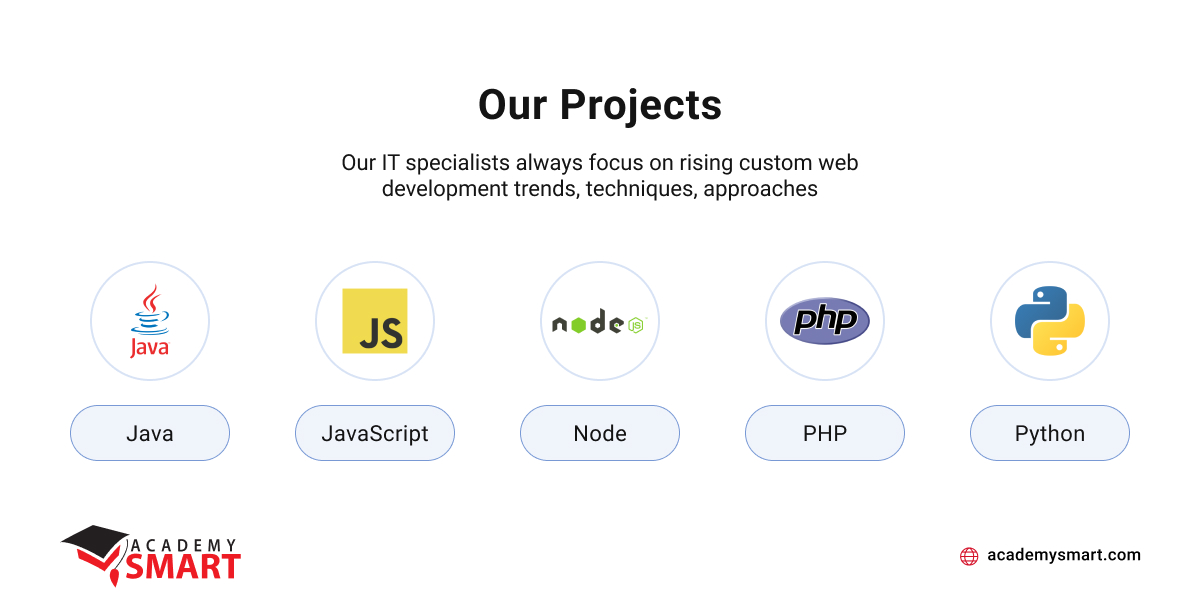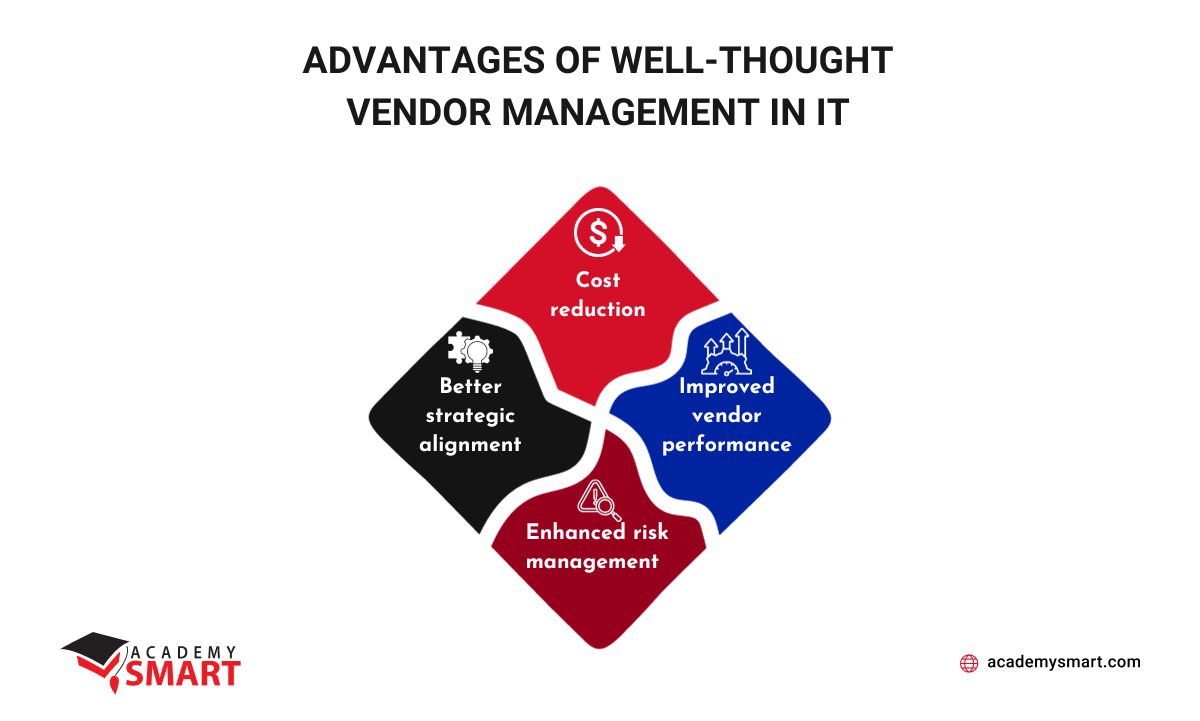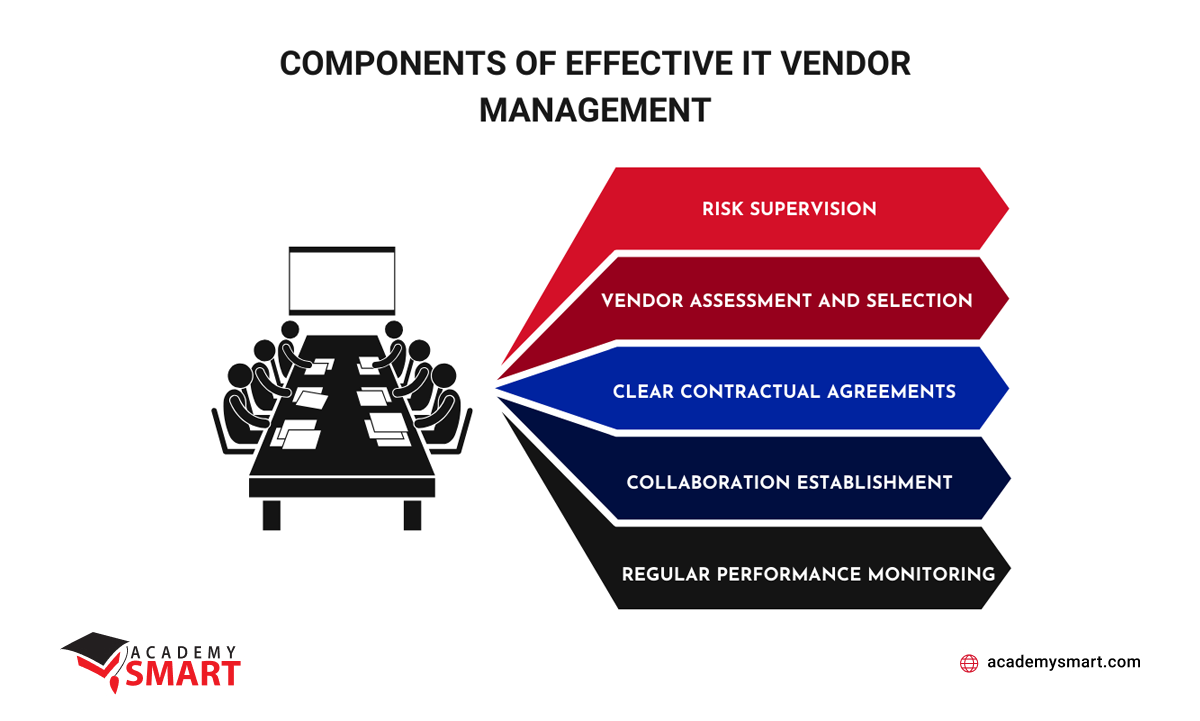
IT Vendor Management: the Process and Best Practices
Contents
Every second enterprise today uses the services of third-party IT providers. It is not surprising since maintaining an in-house IT department for a business that is only indirectly related to information technology is quite expensive. In the context of widespread digitalization, cooperation with outsourcing and outstaffing IT companies is a common and cost-effective practice. However, proper organization and monitoring of the performance of 3rd party IT service suppliers remains essential. This article will introduce you to the basics of IT vendor management and give you practical tips on improving it.
What is IT Vendor Management
IT vendor management is the comprehensive business process through which organizations oversee and optimize their relationships with external IT service providers. This multifaceted approach aims to maximize the benefits derived from these partnerships, extending beyond mere cost control. The key components of vendor management in the IT sphere encompass:
- Provider Selection
This critical step involves choosing vendors that align with the organization’s strategic objectives and long-term vision. The selection process considers expertise, capabilities, and alignment with business goals. - Contract management
The negotiation of clear and mutually beneficial contractual agreements is essential. These contracts define terms and conditions that satisfy the enterprise and its vendors, ensuring a solid foundation for collaboration. - Performance monitoring
Vigilant oversight of supplier performance is vital to upholding service excellence. Metrics and Key Performance Indicators (KPIs) are tracked to assess whether vendors meet the agreed-upon standards and expectations. - Relationship supervision
Establishing and nurturing solid, collaborative relationships with IT providers is vital to productive vendor management. Effective communication and cooperation facilitate problem-solving, innovation, and successful partnerships. - IT vendor risk management
Identifying and mitigating potential risks, such as data breaches or compliance issues, are integral aspects of the process. Companies need to have strategies in place to address and minimize these risks effectively.
Furthermore, the process may contain clearly stated policies, procedures, technology solutions, and specific IT vendor management software. Such corporate applications centralize vendor information, streamline communication, automate routine tasks, and enhance efficiency.
The IT supplier manager is typically assigned to individuals (CTO, engineering experts or IT leads) or teams competent to oversee these processes. Their role and responsibilities are to ensure that vendor relationships are well-managed, contracts are adhered to, performance is monitored, and risks are minimized. Over the years of our company’s work, project managers and technical experts at Academy Smart have managed third-party IT projects and provided their services for creating software applications as contractors many times. You may see such delivered products in the video presentation of our portfolio.
Why IT Vendor Management is Important
IT provider management has essential specificity due to the dynamic nature of the industry and the complexities associated with managing various IT suppliers. The traditional procurement approach, primarily focused on cost reduction and contract negotiations, is no longer sufficient. Instead, enterprises need a strategic managing approach to address the following challenges:
- Evolving IT needs
The IT industry is constantly changing, with evolving business and technology requirements. Organizations must balance adapting to these changes while meeting the latest security standards and customer expectations. Focusing on innovation and collaboration with IT service providers and digitalizing the business processes becomes critical in this context. - Contract complexity
Contract negotiation, often led by procurement specialists, can result in rigid and unrealistic agreements prioritizing cost savings over flexibility. A lack of understanding of the specifics of IT contracts among involved teams can lead to inefficiencies and discrepancies in contract negotiations. Consequently, companies may be locked into agreements that no longer align with their changing needs. - Inaccurate expectations
Setting adequate expectations for supplier performance is essential, but it can be challenging. Wrong vendor assessment, ambiguities in requirements, and ineffective communication can lead to discrepancies between expectations and delivery. To mitigate this, due diligence, performance indicators, and effective communication must be prioritized throughout the vendor management lifecycle. - Lack of involvement
When businesses ignore the importance of strategic vendor management, they may not allocate the necessary resources and budget to the process. Additionally, service provider control can become fragmented and ineffective without a centralized policy supported by all departments.
Now, you may see why vendor management in IT is so important. To overcome these challenges, organizations must develop a comprehensive business strategy that considers the rapidly changing IT trends, emphasizes contract flexibility, sets realistic performance expectations, and secures support and resources from all company levels. By doing so, they can navigate the complexities of vendor relationships and ensure that these partnerships align with their long-term business goals effectively. On our portfolio page, you may find examples of such productive cooperation with an offshore IT company.

Projects delivered by Academy Smart
Benefits of IT Vendor management process optimization
The advancement of the IT vendor management framework yields significant benefits for organizations. When managed efficiently, IT providers can become valuable collaborators, bringing fresh ideas, technologies, and perspectives to the business. That enhances the enterprise’s competitive edge and ensures it remains agile and adaptable in the ever-evolving market.
Cost reduction
Companies can get favorable rates and terms by establishing long-term IT supplier relationships. Effective vendor management also ensures efficient resource utilization, ultimately contributing to lower IT expenditure and improved financial sustainability. That helps get the best value for IT investments and avoids costly disputes and litigation.
Improved vendor performance
Enterprises gain a comprehensive view of vendor performance by implementing a structured IT supplier management process and industry-specific key performance indicators (KPIs). This clarity and consistency in expectations enable vendors to deliver better results. Furthermore, streamlining internal operations through vendor management systems and open communication channels ensures that the quality and value of services consistently meet or exceed customers’ needs, ultimately leading to improved overall performance.
Enhanced risk management
IT vendor risk management tools establish robust trouble identification and mitigation guidelines and procedures. These measures help safeguard confidential company data, mitigate the risk of delivery failures or supply chain disruptions, and designate emergency response plans. Moreover, the process helps reduce project-related risks by implementing consistent data protection policies, regularly assessing vendor deliverables against project objectives, and fostering clear and concise communication with vendors. By doing so, companies can lower the chance of security breaches, minimize reliance on a single vendor, and reduce the likelihood of vendor churn, ultimately ensuring a more secure and stable operational IT environment.
Better strategic alignment
Through effective vendor management practices, businesses can enhance their IT supplier selection to align with the company’s broader strategic goals and vision rather than focusing on project-specific objectives. This forward-thinking approach reduces disruptions in IT service provider sourcing and saves valuable time and resources. Furthermore, the process increases the likelihood of establishing long-term partnerships, fostering trust, and nurturing win-win relationships between the organization and its vendors.

Advantages of well-thought vendor management in IT
Best Practices to Establish Efficient IT Vendor Management: Common Tips
To ensure success in IT plans and operations, enterprises use a two-fold approach: selecting vendors aligned with business goals and strategies and managing their relationships to ensure sustained high performance while mitigating potential risks.
Companies must establish clear supplier policies, categorize IT providers based on risk assessment, craft comprehensive contracts, monitor their performance diligently, and maintain transparent reporting mechanisms to achieve these objectives. Below, we will explore the essential best practices that form the foundation of efficient IT supplier management, fostering successful partnerships and optimized outcomes.
Risk supervision
Begin by aligning your IT vendor management strategy with your company’s needs, objectives, and vision. Determine your primary focus, whether it’s cost reduction, innovation, service quality, or other factors while considering user requirements and market trends.
Before selecting suppliers, identify potential bottlenecks related to the transfer of access to enterprise IT resources and sensitive corporate information, interaction with departments, timing, and budget. Consider factors such as regulatory compliance, the latest legal innovations in the industry, data security, and intellectual property protection. Identifying risks at this stage is crucial to making informed vendor choices later.
Vendor assessment and selection
Start by defining your vendor selection criteria, aligning them with your company’s values and long-term strategy rather than solely focusing on immediate project requirements. Significant characteristics may encompass comprehensive solution offerings, industry reputation, financial stability, customer satisfaction, pricing, digital security track records, technical support, and scalability.
Formalize the choosing process by creating a bid document that encapsulates your business requirements and the questions you need IT providers to address. This document acts as a guide for both your organization and prospective suppliers, ensuring clarity and alignment. Typically, it should contain project scope and objectives, technical and functional requirements, timeline and milestones, budget, vendor qualifications, expectations and questions for suppliers, and legal and contractual terms.
Cast a wide net when researching IT vendors. Utilize your professional network, conduct online searches, explore forums, and consult vendor listing sites. Platforms like Clutch can provide valuable insights through reviews and ratings. Once you’ve identified potential providers that meet your selection criteria, initiate formal contact and evaluation. Share your bid document and request formal bids from vendors. This period allows for a deeper understanding of vendor capabilities and alignment with your organization’s needs.
Clear contractual agreements
Precise and compelling contractual agreements are the foundation of successful IT vendor management.
Begin by plainly defining the project scope of work. It should include a detailed description of the work to be performed, a timeline for completion, and specific deliverables. Collaboratively define roles and responsibilities with the vendor to promote early buy-in and alignment. Draft a document outlining proposed roles and responsibilities and seek the provider’s input. Assign individual owners to tasks or deliverables and communicate these responsibilities to all involved parties. A well-defined project scope ensures that both parties have a shared understanding of mutual expectations.
Rather than setting strict terms that solely guard your interests, adopt a collaborative approach that seeks joint benefits. While covering essential aspects like cost, services, and project duration, also pay attention to confidentiality and non-compete clauses. When establishing contractual agreements, consider long-term implications beyond the immediate project. That may include having provisions for transferring to another IT vendor if necessary. Ensure that the contract allows for a smooth transition, protecting your data, intellectual property, and ongoing operations in case of a provider change. An equitable agreement builds trust and fosters a more productive supplier-client relationship.
When negotiating contracts with IT vendors, maintain clarity and focus on these critical points:
- understand the IT vendor’s business model and motivations;
- obviously articulate your project needs and objectives;
- research market rates for the services to ensure fair pricing;
- comprehend the legal terms and conditions to protect your interests;
- be prepared to walk away if the provider is unwilling to meet your needs.
By following these practices, organizations can establish transparent, fair, and efficient contractual agreements, laying the groundwork for successful vendor partnerships and risk mitigation.
Collaboration establishment
Leverage your company’s formal procurement processes to establish appropriate workflows with your IT service providers. Utilize procurement teams to help define them according to company standards. Consider implementing IT vendor management software to streamline communication, document sharing, and performance tracking. Such tools provide a centralized platform for collaboration, making it easier to manage vendor relationships efficiently.
Compile all necessary information and documents for IT supplier onboarding, such as payment details, licenses, accesses needed, and insurance information. Ensure that your organization can promptly meet its financial commitments to providers. Assign dedicated managers to work with vendors and communicate how the new contract will impact other departments.
Foster a productive working relationship by striving to understand your vendors’ business processes and needs, just as you expect them to understand yours. While maintaining confidentiality, share crucial information such as project timelines and changes in product plans when relevant. Effective collaboration is built on mutual understanding and information sharing.
Maintain open communication lines, hold regular meetings to update on progress, discuss concerns, and solicit feedback. Demonstrate fairness and reasonableness in your interactions, considering your IT providers’ needs and promptly addressing concerns. Stay flexible and open to vendor changes or suggestions, as they often bring valuable insights and expertise.
Regular performance monitoring
Clearly define the metrics and key performance indicators (KPIs) you will use to evaluate vendor performance. These metrics may include customer service levels, delivery timelines, service quality, and adherence to contractual terms. During performance measures, set specific goals such as assessing deliverables against project objectives, exploring cost-saving opportunities through contract negotiations, addressing missed deadlines or poor performance, identifying contract compliance issues, and benchmarking the vendor’s performance against previous or current vendors.
Establish a regular meeting schedule with your vendors to discuss project progress, performance, and feedback. These meetings should focus on more than just addressing problems but also on sharing constructive feedback and identifying areas of improvement.
Conduct annual vendor performance reviews to assess the vendor’s contributions to your organization comprehensively. More frequent checks may be necessary if there are concerns about productivity. Vendor management software can automate performance review triggers, but personal interaction with vendors remains essential.

Components of effective IT supplier management
How Academy SMART can help you with your IT Vendor Management Challenges
IT agency Academy Smart offers you the benefit of our company’s multi-faceted experience as a custom software developer for enterprises.
At your service are experts in IT project management, business analytics, cloud deployment, and full-stack web and mobile app development. With the help of our HR department, you will hire the outstaffing specialists you need for software development and maintenance or assemble a dedicated team to build turnkey applications, including comprehensive vendor management systems. Contacting our team will allow you to quickly and smoothly transition to a more proficient and resourceful IT service supplier.
Get in touch to share the challenges you face.
IT Vendor Management: Frequently Asked Questions
What is IT Vendor Management?
IT vendor management is the systematic process by which enterprises oversee and optimize their relationships with external IT service providers to achieve cost-effective, efficient, and strategic outcomes in line with their business objectives.
What are IT Vendor Management Software examples?
Some IT vendor management software examples include ServiceNow Vendor Performance Management, GEP SMART, and SAP Ariba. These platforms help organizations automate and streamline supplier management tasks, from vendor selection and contract management to performance monitoring and risk assessment.
Book a free consultation

Reach out to start talking today!











